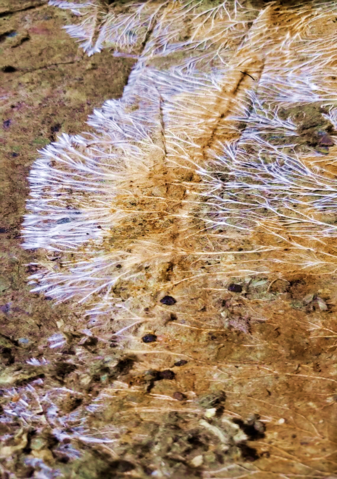
Mycorrhizal Fungi Benefits and Mycelium Growth in PittMoss
Recently our team came across a great example of mycelium growing in PittMoss. We asked soil scientist, Dr. Chuck Bethke, to write up a summary of what is seen in this photo along with some background information on the benefits of mycorrhizae for plants. Check out the photo below along with Dr. Bethke’s analysis!

“The adjacent photo shows beneficial FUNGAL mycelium growing on the surface of a PittMoss® blend. MYCELIUM is the collective term used to describe the network of fungal filaments, called hyphae, that grow like roots throughout a substrate. Mycelium of beneficial microbes readily and extensively grow on and within PittMoss® fibers. In this surface view (from along the edge of a block of a PittMoss® blend) it is possible to see the extent of that natural growth. (Note that the black specks are about ¼” in width and the photo covers about 3 square feet.) This broad and extensive microbial development demonstrates one key to the effectiveness of PittMoss®. The PittMoss® amendment provides the perfect environment for microbial growth. PittMoss® has a high surface area, located within a microbial “food” source, that delivers moisture and nutrients, all while allowing for effective aeration. All these properties work together to produce the exceptional biological environment. This extensive microbial development provides for extraordinary populations of beneficial microbes that can also serve to competitively inhibit disease causing pathogens.
For years MYCORRHIZAL fungi have been recognized as beneficial. It has been said that about 95% of all plants require, or benefit from, mycorrhizal associations. Mycorrhizae are recognized to greatly extend the “penetration” and effectiveness of roots in obtaining nutrients (especially phosphorus and nitrogen) and thriving under moisture stress. Even under adverse conditions native and inoculated mycorrhizal propagules can thrive in PittMoss®. These propagules can permeate PittMoss® providing close contact with plant roots and inoculating them. It is necessary that the mycorrhizal propagules are in close contact with the roots to be rapidly effective. Wide distribution in PittMoss® then allows for rapid inoculation of roots providing for a nearly immediate response. Additions of PittMoss® media can help to make most substrates into “living soils”.
Advancements in sustainable horticulture require that recycled waste materials be used to develop the next generation of growing substrates. Remember that living soils are the most natural way to maintain a sound interrelationship with the natural systems, and they foster symbiotic relationships within the microbial and plant world. With PittMoss®, many of these goals are promoted, and help to provide for more natural, biological, and sustainable growing environments.”
– C.L.Bethke, pH. D. 07/13/2019

Add comment
You must be logged in to post a comment.